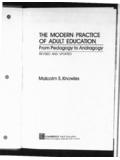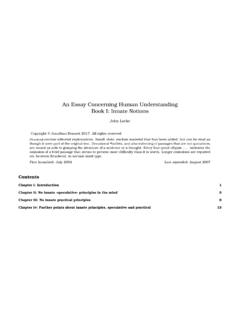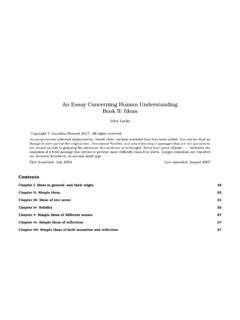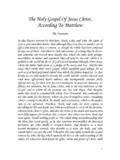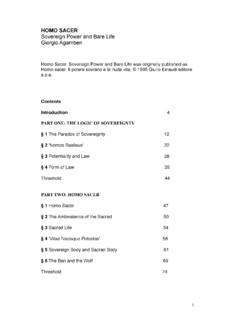Transcription of Racial Microaggressions in Everyday Life - World …
1 Racial Microaggressions in Everyday LifeImplications for Clinical PracticeDerald Wing Sue, Christina M. Capodilupo, Gina C. Torino, Jennifer M. Bucceri,Aisha M. B. Holder, Kevin L. Nadal, and Marta EsquilinTeachers College, Columbia UniversityRacial Microaggressions are brief and commonplace dailyverbal, behavioral, or environmental indignities, whetherintentional or unintentional, that communicate hostile, de-rogatory, or negative Racial slights and insults towardpeople of color. Perpetrators of Microaggressions are oftenunaware that they engage in such communications whenthey interact with Racial /ethnic minorities. A taxonomy ofracial Microaggressions in Everyday life was createdthrough a review of the social psychological literature onaversive racism, from formulations regarding the manifes-tation and impact of Everyday racism, and from readingnumerous personal narratives of counselors (both Whiteand those of color) on their Racial /cultural seem to appear in three forms: microas-sault, microinsult, and microinvalidation.
2 Almost all inter- Racial encounters are prone to Microaggressions ; this ar-ticle uses the White counselor client of color counselingdyad to illustrate how they impair the development of atherapeutic alliance. Suggestions regarding education andtraining and research in the helping professions are :microaggression, microassault, microinsult, mi-croinvalidation, attributional ambiguityAlthough the civil rights movement had a signifi-cant effect on changing Racial interactions in thissociety, racism continues to plague the UnitedStates (Thompson & Neville, 1999). President Clinton sRace Advisory Board concluded that (a) racism is one ofthe most divisive forces in our society, (b) Racial legacies ofthe past continue to haunt current policies and practices thatcreate unfair disparities between minority and majoritygroups, (c) Racial inequities are so deeply ingrained inAmerican society that they are nearly invisible, and (d)most White Americans are unaware of the advantages theyenjoy in this society and of how their attitudes and actionsunintentionally discriminate against persons of color (Ad-visory Board to the President s Initiative on Race, 1998).
3 This last conclusion is especially problematic in the mentalhealth professions because most graduates continue to beWhite and trained primarily in Western European modelsof service delivery (D. W. Sue & Sue, 2003). For thatreason, this article focuses primarily on White therapist client of color White therapists are members of the largersociety and not immune from inheriting the Racial biases oftheir forebears (Burkard & Knox, 2004; D. W. Sue, 2005),they may become victims of a cultural conditioning processthat imbues within them biases and prejudices (Abelson,Dasgupta, Park, & Banaji, 1998; Banaji, Hardin, & Roth-man, 1993) that discriminate against clients of color.
4 Overthe past 20 years, calls for cultural competence in thehelping professions (American Psychological Association,2003; D. W. Sue, Arredondo, & McDavis, 1992) havestressed the importance of two therapist characteristicsassociated with effective service delivery to Racial /ethnicminority clients: (a) awareness of oneself as a Racial /cul-tural being and of the biases, stereotypes, and assumptionsthat influence worldviews and (b) awareness of the World -views of culturally diverse clients. Achieving these twogoals is blocked, however, when White clinicians fail tounderstand how issues of race influence the therapy processand how racism potentially infects the delivery of servicesto clients of color (Richardson & Molinaro, 1996).
5 Thera-pists who are unaware of their biases and prejudices mayunintentionally create impasses for clients of color, whichmay partially explain well-documented patterns of therapyunderutilization and premature termination of therapyamong such clients (Burkard & Knox, 2004; Kearney,Draper, & Baron, 2005). In this article, we describe andanalyze how racism in the form of Racial microaggressionsis particularly problematic for therapists to identify; pro-pose a taxonomy of Racial Microaggressions with potentialimplications for practice, education and training, and re-search; and use the counseling/therapy process to illustratehow Racial Microaggressions can impair the therapeuticalliance.
6 To date, no conceptual or theoretical model ofEditor s Comas-D az served as the action editor for thisarticle before Derald Wing Sue joined theAmerican PsychologistEdito-rial Board as an associate editor on January 1, Wing Sue, Christina M. Capodilupo, Gina , Jennifer M. Bucceri, Aisha M. B. Holder, Kevin L. Nadal, andMarta Esquilin, Department of Counseling and Clinical Psychology,Teachers College, Columbia M. B. Holder is now at Fordham concerning this article should be addressed to De-rald Wing Sue, Department of Counseling and Clinical Psychology, Box36, Teachers College, Columbia University, 525 West 120th Street, NewYork, NY 10027.
7 E-mail: June 2007 American PsychologistCopyright 2007 by the American Psychological Association 0003-066X/07/$ 62, No. 4, 271 286 DOI: Microaggressions has been proposed to explain theirimpact on the therapeutic Changing Face of RacismIn recent history, racism in North America has undergonea transformation, especially after the post civil rights erawhen the conscious democratic belief in equality for groupsof color directly clashed with the long history of racism inthe society (Jones, 1997; Thompson & Neville, 1999). Themore subtle forms of racism have been labeledmodernracism(McConahay, 1986),symbolic racism(Sears, 1988),andaversive racism(Dovidio, Gaertner, Kawakami, &Hodson, 2002).
8 All three explanations of contemporaryracism share commonalities. They emphasize that racism(a) is more likely than ever to be disguised and covert and(b) has evolved from the old fashioned form, in whichovert Racial hatred and bigotry is consciously and publiclydisplayed, to a more ambiguous and nebulous form that ismore difficult to identify and appears that modern and symbolic racism are mostclosely associated with political conservatives, who dis-claim personal bigotry by strong and rigid adherence totraditional American values (individualism, self-reliance,hard work, etc.), whereas aversive racism is more charac-teristic of White liberals (Dovidio & Gaertner, 1996, 2000).
9 Aversive racists, according to these researchers, arestrongly motivated by egalitarian values as well as antimi-nority feelings. Their egalitarian values operate on a con-scious level, while their antiminority feelings are less con-scious and generally covert (DeVos & Banaji, 2005). Insome respects, these three forms of racism can be orderedalong a continuum; aversive racists are the least con-sciously negative, followed by modern and symbolic rac-ists, who are somewhat more prejudiced, and finally byold-fashioned biological racists (Nelson, 2006).Although much has been written about contemporaryforms of racism, many studies in health care (Smedley &Smedley, 2005), education (Gordon & Johnson, 2003),employment (Hinton, 2004), mental health (Burkard &Knox, 2004), and other social settings (Sellers & Shelton,2003) indicate the difficulty of describing and definingracial discrimination that occurs via aversive racism or implicit bias ; these types of racism are difficult to iden-tify, quantify, and rectify because of their subtle, nebulous,and unnamed nature.
10 Without an adequate classification orunderstanding of the dynamics of subtle racism, it willremain invisible and potentially harmful to the well-being,self-esteem, and standard of living of people of color ( of Health and Human Services, 2001). Ironi-cally, it has been proposed that the daily common experi-ences of Racial aggression that characterize aversive racismmay have significantly more influence on Racial anger,frustration, and self-esteem than traditional overt forms ofracism (Solo rzano, Ceja, & Yosso, 2000). Furthermore, theinvisible nature of acts of aversive racism prevents perpe-trators from realizing and confronting (a) their own com-plicity in creating psychological dilemmas for minoritiesand (b) their role in creating disparities in employment,health care, and Manifestation of RacialMicroaggressionsIn reviewing the literature on subtle and contemporaryforms of racism, we have found the term Racial microag-gressions to best describe the phenomenon in its everydayoccurrence.


